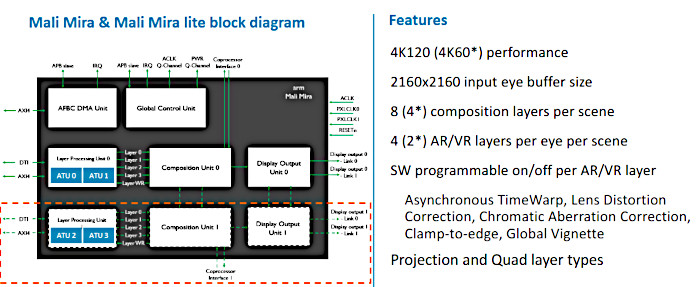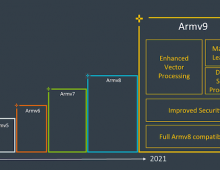
Arm’s Mira Display Solution For VR and AR Headsets Coming This Year
Arm will make available later this year Mira, a new display solution that promiss to change the way think about heterogeneous computing for future VR/AR headsets.
Previewed at the Arm Tech Symposia events towards the end of 2018, Mira will enable significant quality improvements for VR content, but can also lead the way to lighter, more comfortable standalone headsets free from any cables.
In addition to offering 4Kp120 display performance and image processing functions for standard smartphone/tablet/DTV sized displays, Mira adds fixed function hardware for three VR/AR processing tasks mandated for head mounted displays.

- Lens Distortion Correction (LDC), pre-distorts the images in order to counter the effect of the lens through the use of programmable distortion splines, so that when they are viewed through the lenses of any VR headset they appear correct, and undistorted.
- Chromatic Aberration Correction (CAC), pre-separates the colour channels in the opposite direction in order to counteract the colour blurring effect caused by the lenses. Lenses are prisms, and so when passing through the lens, the image undergoes colour channel splitting which is the cause of the blurring.
- Last, but by no means least, Mira performs Asynchronous TimeWarp (ATW), which re-projects the content such that its "real-world" orientation remains constant. In other words, it rotates and/or translates the scene according to the latest head pose and position of the headset in the 3D space.
The Mira demo at the Tech Symposia events consisted of a smartphone running Google’s ARCore and together with the Inertial Measurement Unit (IMU) provides the Six Degrees of Freedom (6DOF) co-ordinates to the Mira Display hardware which is sitting inside the FPGA.

When rendering a VR scene, LDC, CAC and ATW will typically consume up to 20 percent of the processing time on the Mali GPU. So, giving back that time to the GPU means more time for it to render the VR scene at much higher resolutions and frame rates. Rendering at higher resolutions provides greater image clarity and is crucial for VR/AR head mounted displays to eliminate artefacts (such as screen door effect caused by the unlit spaces between pixels), which appear due to the proximity of one’s eyes to the display. In addition, rendering at much higher frame rates (90 to 120 frames per second (fps)) will eliminate ghost artefacts on low persistence LCD panels and reduce the overall motion-to-photon latency (thus preventing motion sickness). Performing ATW at the last stage of the multimedia pipeline with Mira (rather than on the GPU) is also favourable, since the VR scene is composed and time warped just-in-time before sending it out to the display; thereby avoiding the associated delay with the extra read and write through memory.

Arm says that the Mira display solution can ensure that the next generation of VR /AR headset devices achieve more than double the pixel throughput of what is achievable today – 4Kp120 (or 2160x2160p120 per eye) at >100° Field of View (FOV) for world-scale wireless VR/AR within the power constraints of a mobile device. VR users will no longer rely on plugging the headset to a PC or console to drive a VR experience. They will also be able to achieve the same immersive experience with a much lighter, more comfortable and untethered VR headset that brings more hours of battery life.





















